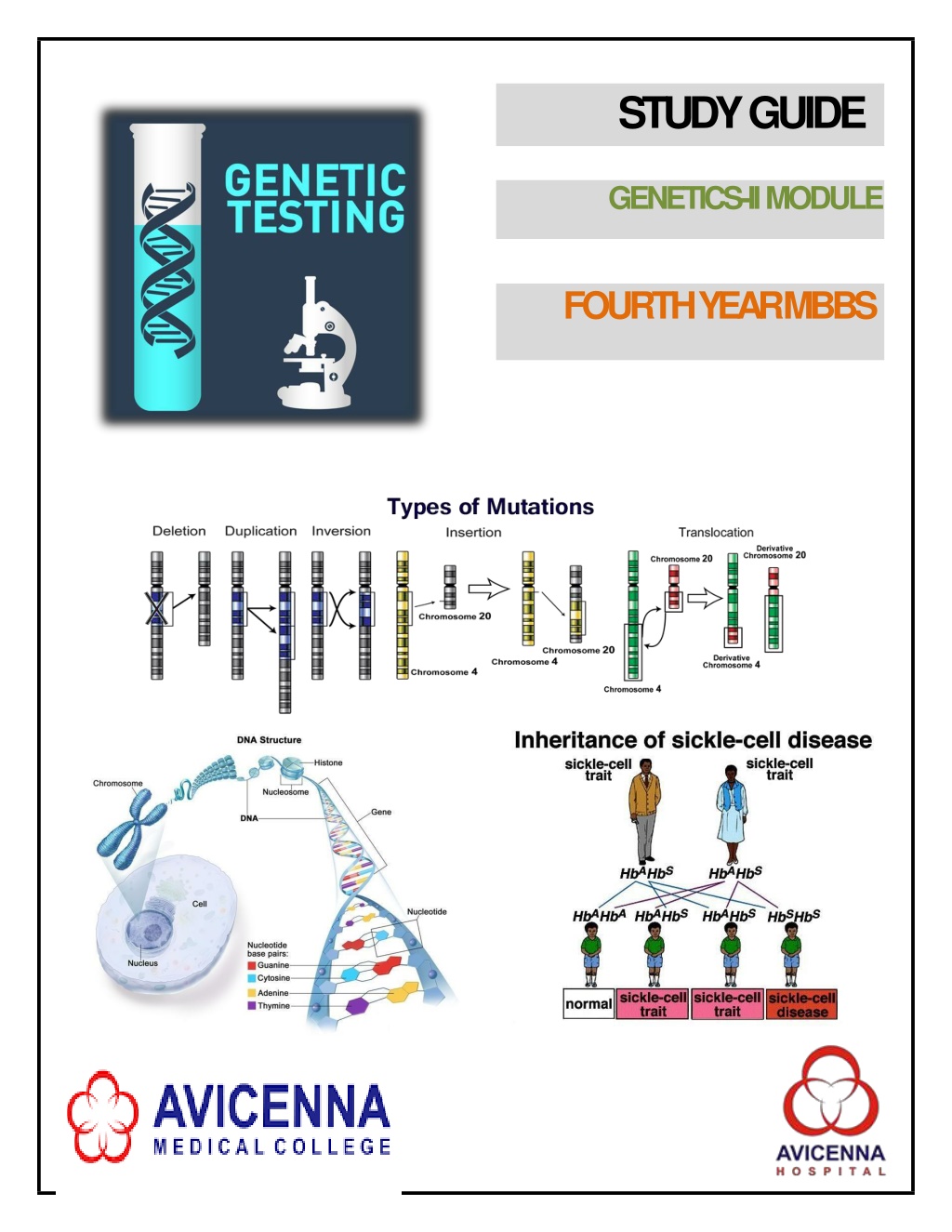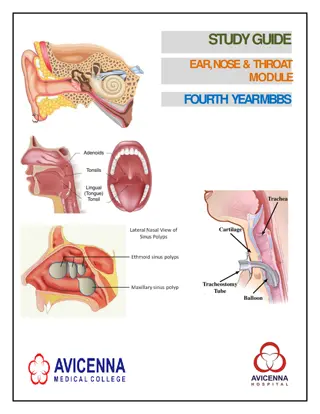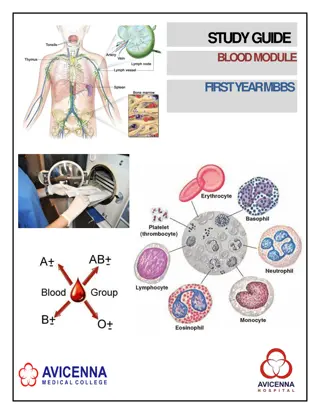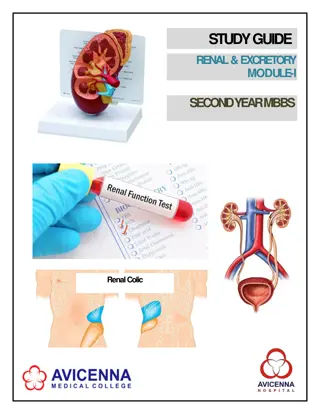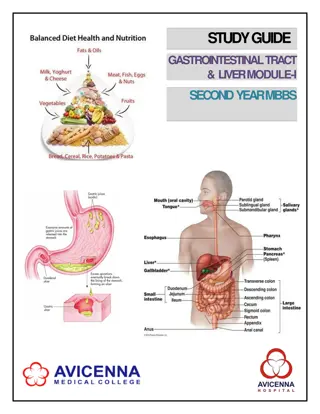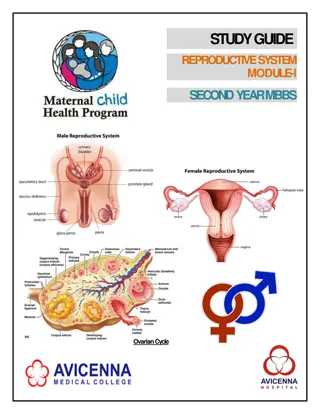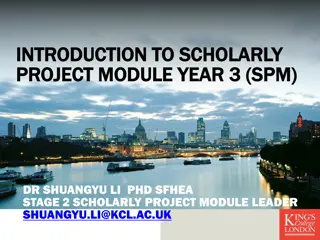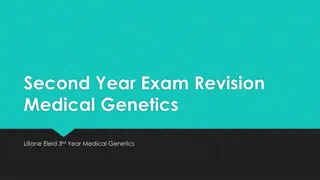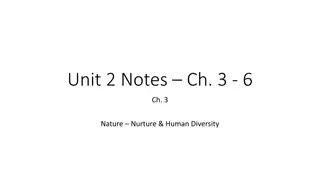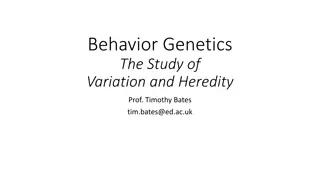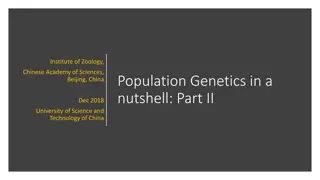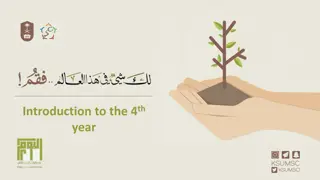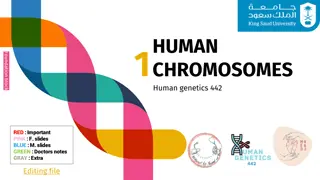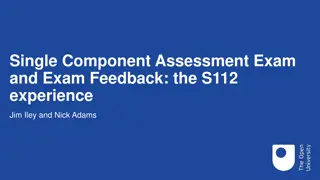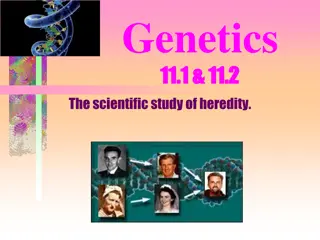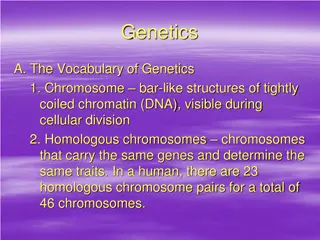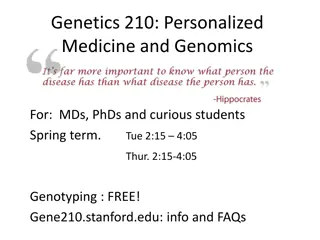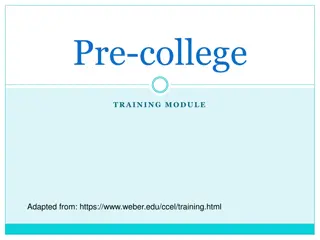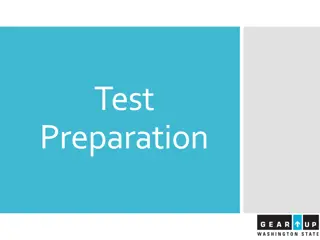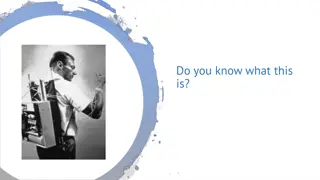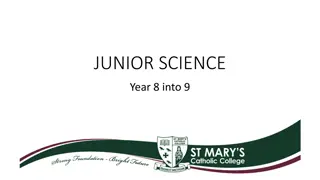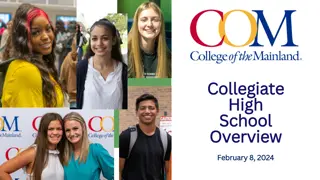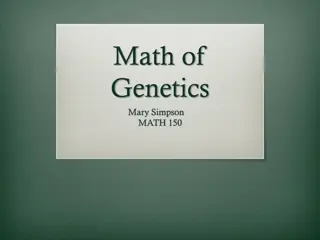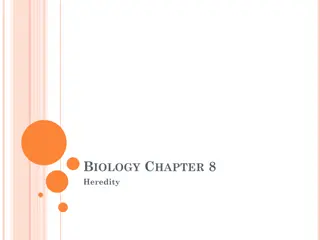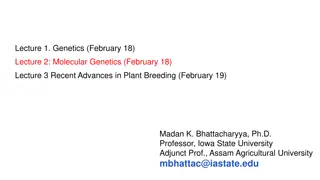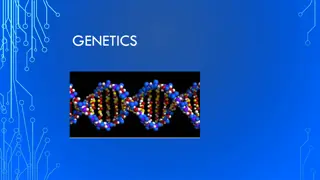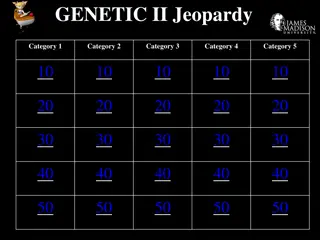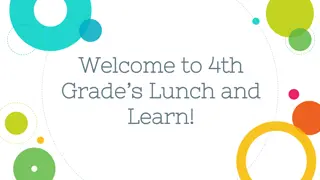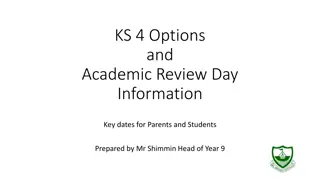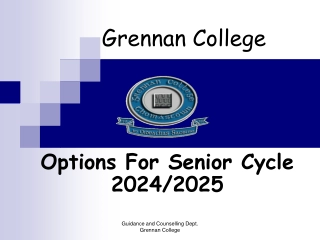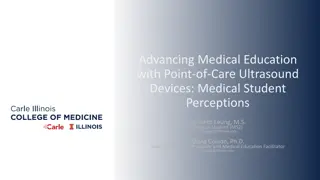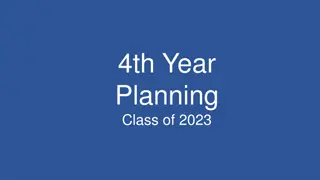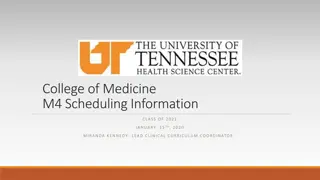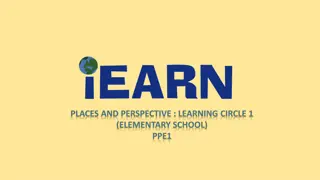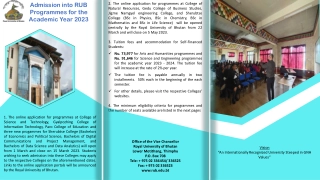Genetics-II Module Study Guide for 4th Year MBBS Students at Avicenna Medical College
This study guide is designed to assist 4th-year MBBS students in understanding the Genetics-II module at Avicenna Medical College. It provides detailed information on module organization, learning strategies, resources, assessment methods, and curriculum framework. Integrated teaching approaches, learning experiences, and curriculum structure are emphasized for a comprehensive understanding of genetics in a clinical context.
Download Presentation

Please find below an Image/Link to download the presentation.
The content on the website is provided AS IS for your information and personal use only. It may not be sold, licensed, or shared on other websites without obtaining consent from the author. Download presentation by click this link. If you encounter any issues during the download, it is possible that the publisher has removed the file from their server.
E N D
Presentation Transcript
STUDYGUIDE GENETICS-IIMODULE FOURTH YEARMBBS
4th YEAR MBBS GENETICS-IIMODULE AVICENNA MEDICAL COLLEGE STUDY GUIDE FOR GENETICS-IIMODULE Page No. 3 4 5 7 7 8 10 10 11 13 14 CONTENTS S.No 1 2 3 4 Overview Introduction to StudyGuide LearningMethodologies Module 3:GENETICS-II Introduction Objectives and LearningStrategies LearningResources Additional LearningResources AssessmentMethods Modular Examination Rules and Regulations(AVMC) Schedule 4.1 4.2 5 5.1 6 7 8 Page | 2
4th YEAR MBBS GENETICS-IIMODULE AVICENNA MEDICAL COLLEGE Module name:Genetics-II Year:Four Duration: 1 week Timetable hours: Interactive Lectures, Case-Based Discussion (CBD), Clinical Rotations, Presentations, Demonstrations, Skills,Self-Study MODULE INTEGRA TEDCOMMITTEE MODULECOORDINATOR: Dr. Yasir Ali(Biochemistry) CO-COORDINATOR: Dr. Nabila akram DEPARTMENTS & RESOURCE PERSONS FACILITATINGLEARNING BASIC HEALTHSCIENCES CLINICAL AND ANCILLARYDEPARTMENTS BIOCHEMISRTY Prof.Dr.Zubair MOLECULARPATHOLOGY Prof. Dr. Saeed PATHOLOGY Prof. Dr> Robeena LNH&MC MANAGEMENT Professorr.Dr. Gulfreen Waheed, Dean & Principal, Director AVMC Dr.Brg. Gul-e-rana Controller AVMC STUDY GUIDE COMPILED BY: Dr. Sadia Awan, Dr. Muhammad Muzzammil Sadiq ,Dr. Usama Bin Ishtiaq Page | 3
4th YEAR MBBS GENETICS-IIMODULE AVICENNA MEDICAL COLLEGE INTRODUCTION WHAT IS A STUDYGUIDE? It is an aidto: Inform students how student learning program of the module has been organized Helpstudentsorganize andmanagetheirstudiesthroughoutthemodule Guide students on assessment methods, rules andregulations THE STUDYGUIDE: Communicates information on organization and management of themodule. Thiswill helpthestudentto contactthe rightpersonin caseof anydifficulty. Definestheobjectiveswhich areexpectedto beachieved at theendof themodule. Identifies the learning strategies such as lectures, small group teachings, clinical skills, demonstration, tutorial and casebasedlearning that will be implemented to achieve the module objectives. Provides a list of learning resources such as books, computer assisted learning programs, web- links,journals,forstudentsto consultin orderto maximize their learning. Highlights information on the contribution of continuous on the student s overallperformance. Includes information on the assessment methods that will be held to determine every student s achievement ofobjectives. Focuses on information pertaining toexamination policy, rules and regulations. CURRICULUMFRAMEWORK Studentswill experience integratedcurriculumsimilar to previousmodules. INTEGRATED CURRICULUM comprises system-based modules such as Eye/ENT, dermatology, genetics, rehabilitation and neurosciences-II & psychiatry modules which link basic science knowledge to clinical problems. Integrated teaching means that subjects are presented as a meaningful whole. Students will be able to have better understanding of basic sciences when they repeatedly learn in relation to clinical examples. LEARNING EXPERIENCES: Case based integrated discussions, Task oriented learning followed by task presentation, skills acquisition in skills lab, computer-based assignments, learning experiences in clinics, wards. Page | 4
4th YEAR MBBS GENETICS-IIMODULE AVICENNA MEDICAL COLLEGE INTEGRA TING DISCIPLINES OF GENETICS-IIMODULE MOLECULAR P A THOLOGY GENETICS-II MODULE P A THOLOGY BIOCHEMISTRY LEARNINGMETHODOLOGIES Thefollowing teaching/ learningmethodsareusedto promotebetterunderstanding: InteractiveLectures Small Group Discussion Case-Based Discussion(CBD) ClinicalExperiences o ClinicalRotations Skillssession INTERACTIVE LECTURES:In large group, the lecturer introduces a topic or common clinical conditions and explains the underlying phenomena through questions, pictures, videos of patients interviews, exercises, etc.Studentsareactively involved in the learningprocess. SMALL GROUP SESSION: This format helps students to clarify concepts, acquire skills or desired attitudes. Sessions are structured with the help of specific exercises such as patient case, interviews or discussion topics. Students exchange opinions and apply knowledge gained from lectures, tutorials and self study. The facilitatorrole isto askprobingquestions,summarize, orrephraseto help clarify concepts. Page | 5
4th YEAR MBBS GENETICS-IIMODULE AVICENNA MEDICAL COLLEGE CASE-BASED DISUCSSION (CBD): A small group discussion format where learning is focused around aseries of questions based on a clinical scenario. Students discuss and answer the questions applying relevant knowledge gained previously in clinical and basic health sciences during the module and construct new knowledge. TheCBDwill beprovided bythe concerndepartment. CLINICAL LEARNING EXPERIENCES:In small groups, students observe patients with signs and symptoms in hospital wards, clinics and outreach centers. This helps students to relate knowledge of basic and clinical sciencesof the module andpreparefor futurepractice. o CLINICAL ROTATIONS: In small groups, students rotate in different wards like Medicine, Pediatrics, Surgery, Obs & Gyne, ENT, Eye, Family Medicine clinics, outreach centers & Community Medicine experiences. Here students observe patients, take histories and perform supervised clinical examinations in outpatient and inpatient settings. They also get an opportunity to observe medical personnel working as a team. These rotations help students relate basic medical and clinical knowledgein diverse clinicalareas. Skills relevant to respective module are observed and practiced where applicable in SKILLSSESSION: skillslaboratory. SELF-DIRECTED STUDY: Students assume responsibilities of their own learning through individual study, sharing and discussing with peers, seeking information from Learning ResourceCenter,teachersand resource persons within and outside the college. Students can utilize the time within the college scheduled hours of self-study. Page | 6
4th YEAR MBBS GENETICS-IIMODULE AVICENNA MEDICAL COLLEGE MODULE 3: GENETICSII INTRODUCTION Agenetic disorder is a disease that is caused by achange, or mutation, in an individual s DNAsequence. These mutations can be due to an error in DNA replication or due to environmental factors, such ascigarette smoke andexposure to radiation, which causechangesin theDNAsequence. Internationally, 3-5% of all births result in congenital malformations; 20-30% of all infant deaths are due to genetic disorders; 30-50% of post-neonatal deaths are due to congenital malformations. 11.1% of pediatric hospital admissions are for children with genetic disorders and 18.5% are children with other congenital malformations; 12%of adult hospital admissions are for genetic causes. 50%of mental retardation, a common global occurrence, hasagenetic basis. Cancersare one of the most dreaded conditions; 15%of all cancershave an inherited susceptibility whereas 10% of chronic diseases (heart, diabetes arthritis) which occur in the adult population haveasignificant geneticcomponent. Pakistan has a high frequency of marriages among close cousins, i.e. consanguineous marriages. This percentage is 62.70 by far the highest among countries in the consanguinity belt which includes countries of the Middle East and the Sub continent. It is estimated that about 29 million people out of Pakistan s 200 million populationsufferfromgeneticdefectsattributable to closeor first-cousin marriages. Hence, it becomes imperative for medical graduates in Pakistan to understand how such conditions occur and how they can be managed and prevented. Since genetics, and the pathophysiology of genetic disorders, is a complex process, this topic was initially dealt with in the first spiral of the curriculum at a simpler level and is now being re-visited at a more advanced level. In the first year, normal genetic processes were described so that learners getaclearunderstandingofhow chromosomesfunction. In this 2nd spiral of Genetics, students will learn about the process of mutations, single gene defects and techniques used to diagnose such disorders. You may experience various genetic disorders during the clinical rotation andclerkship. Reference: JSMU Study guide dated May 10th,2018 Page | 7
4th YEAR MBBS GENETICS-IIMODULE AVICENNA MEDICAL COLLEGE COURSE OBJECTIVES ANDSTRA TEGIES By the end of Genetics-II module students should be ableto: OBJECTIVES TEACHINGSTRATEGY BIOCHEMISTRY Describe the process of DNA Replication andrepair Interactive Lectures/SmallGroup Discussion Explain the mechanism of Transcription and PostTranscriptional Modification Discuss the Modification process of Translation and Post Translational MOLECULARPATHOLOGY Interactive Lectures/SmallGroup Discussion Discuss the basic concepts of genetics including DNA and RNA structure, Mendel s Laws of inheritance and PedigreeChart Mutations List the differenttypesof mutations in the codingandnon-coding regions ofgenes Distinguishbetweenthe differenttypesof mutations in the coding and non-coding regions of genes that result in phenotypicchange Differentiate between spontaneous and inducedmutations Explain howapoint mutationsor frameshift mutationin agene may alterthe activity of the proteinit encodes Interactive Lectures Single genedisorders Define single genedisorders List different types of single genedisorders List characteristics of single gene which gives variationin expression of diseases Describe genetic changes which occur in thesedisorders Genetictechniques Discuss the basic principles of recombinant genetic techniquesand theirapplicationsinthedetectionof geneticdiseaseswhich includes PCR, FISH, RFLP,BLOTTING Small Group Discussion/Interactive Lectures Page | 8
4th YEAR MBBS GENETICS-IIMODULE AVICENNA MEDICAL COLLEGE PrenatalDiagnosis Define prenataldiagnosis List different techniques used for prenataldiagnosis List the advantages and disadvantages of prenataldiagnosis Justify indications for and utility of prenataldiagnostic tests Interactive Lectures Gene Therapy & Counseling Describe how gene therapyworks Explain the tools and techniques used to deliver gene therapies, to the disease candidates for gene therapy and associated risks and challenges PATHOLOGY Pathophysiology of Inheritance Explain the pathophysiology of classical and non-classical mode of inheritance of geneticdiseases Interactive Lecture Discuss the clinical features of important genetic disorders which includes Down s syndrome, Turner s syndrome, Cystic Fibrosis, Sickle Cell Anemia,Thalassemia SmallGroup Discussion Apart from attending daily scheduled sessions, students too should engage in self-study to ensure that all the objectives arecovered Page | 9
4th YEAR MBBS GENETICS-IIMODULE AVICENNA MEDICAL COLLEGE LEARNINGRESOURCES SUBJECT RESOURCES TEXTBOOKS 1. Harper s IllustratedBiochemistry 2. Lehninger Principle ofBiochemistry 3. Biochemistry byDevlin BIOC HEMIS TRY TEXTBOOKS 1. Robbins & Cotran, Pathologic Basis of Disease, 9thedition. 2. Rapid Review Pathology, 4th edition by Edward F. GoljanMD PATHOLOGY WEBSITES: 1. http://library.med.utah.edu/WebPath/webpath.html 2. http://www.pathologyatlas.ro/ REFERENCEBOOK: 1. Thompson & Thompson Genetics in Medicine 8th Edition MOLECULARPATHOLOGY ADDITIONAL LEARNINGRESOURCES Hands-on Activities/PracticalStudents will be involved in Practical sessions and hands-on activitiesthat link with the Genetics-II Module toenhance learning. Models available in the museum are a rich learning resource forquick Museum review of anatomy and relatededucational activities Skills acquisition in a simulated environment in theskills lab involving experiential learning will ensurepatientsafety andwill alsohelp to build SkillsLab confidence in approaching thepatients Videos and podcasts will familiarize the student withthe procedures and protocolwhich theycanwatch andlistento atanytimeandwherever they Videos/Podcasts are, as part of task orientedlearning Students will use easily accessible internet resources with added time InternetResources flexibilityto enrichandupdatetheirknowledge anditsapplication Page | 10
4th YEAR MBBS GENETICS-IIMODULE A VICENNA MEDICA L COLLEGE ASSESSMENTMETHODS: Theory: o Best Choice Questions (BCQs) also known as MCQs (Multiple Choice Questions) are used to assess objectives covered in eachmodule. A BCQ has a statement or clinical scenario followed by four options (likelyanswer). Students after reading the statement/scenario select ONE, the most appropriate response from the given list ofoptions. Correct answer carries one mark, and incorrect zero mark . There is no negative marking. Studentsmarktheirresponsesonspecifiedcomputer-based/OMRsheetdesignedfor AVMC OSPE/OSCE: Objective Structured Practical/ClinicalExamination: Eachstudentwill beassessedonthe samecontentandhavesametimeto completethe task. Comprise of 12-25stations. Each station may assess a variety of clinical tasks, these tasks may include history taking, physical examination, skills and application of skills andknowledge Stations are observed, unobserved, interactive and reststations. Observed and interactive stations will be assessed by internal orexternal examiners. Unobserved will be static stations in which there may be an X-ray, Labs reports, pictures, clinical scenarioswith relatedquestionsforstudentstoanswer. Rest station is a station where there is no task given and in this time student can organize his/her thoughts. InternalEvaluation Students will beassessedto determine achievement of moduleobjectivesthroughthefollowing: Module Examination: will be scheduled on completion of each module. The method of o examination comprises theory exam which includes BCQs and OSPE (Objective Structured Practical Examination). Graded Assessment of students by Individual Department: Quiz, viva, practical, assignment, small o group activities such as CBL, TBL, TOL, online assessment, ward activities, examination, and log book. Marksof bothmodular examinationandgradedassessmentwill constitute 20%weightage. As per UHS policy, this 20% will be added by UHS to Final TheoryExamination. Page | 11
4th YEAR MBBS GENETICS-IIMODULE AVICENNA MEDICAL COLLEGE Example : Number of Marks allocated for Final Theory and Internal Evaluation InternalEvaluation (Class test +Assignments + Modular Exam) 20% Final Examination TheoryMarks Total(Theory) Semester 80% 100% FormativeAssessment Individual department may hold quiz or short answer questions to help students assess their own learning. The marks obtained are not included in the internalevaluation More than 75% attendance is needed to sit for the modularexaminations Page | 12
4th YEAR MBBS GENETICS-IIMODULE A VICENNA MEDICA L COLLEGE MODULAR EXAMINATION RULES & REGULATIONS(AVMC) Studentmustreportto examinationhall/venue, 30 minutesbeforetheexam. Exam will begin sharp at the giventime. No student will be allowed to enter the examination hall after 15 minutes of scheduled examinationtime. Studentsmust sitaccordingto theirroll numbersmentioned ontheseats. Cell phones are strictly not allowed in examinationhall. If anystudentisfoundwith cell phonein anymode(silent, switchedoffor on)he/shewill benot be allowed to continue theirexam. No students will be allowed to sit in exam without University Admit Card, AVMCCollege ID Card and LabCoat Student must bring the following stationary items for the exam: Pen, Pencil, Eraser, and Sharpener. Indiscipline in the exam hall/venue is not acceptable. Students must not possess any written materialorcommunicatewith theirfellowstudents. UHS GradingSystem It will be based on GPA 4system Marks obtained in Percentagerange NumericalGrade AlphabeticalGrade 80-100 4.0 A+ 75-79 4.0 A 70-74 3.7 A- 67-69 3.3 B+ 63-66 3.0 B 60-62 2.7 B- 56-59 2.3 C+ 50-55 2.0 C <50 Un-grade-able 0 U A candidate obtaining GPA less than 2.00 (50%) is declared un-graded(fail). Cumulativetranscriptisissuedat the endof clearance of all modules. Page | 13
